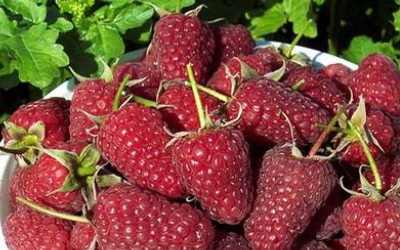
- Authors: Switzerland
- Repairability: Yes
- Berry color: dark red
- Taste: sweet
- Berry weight, g: 2,5-3,0
- Yield: 4-5 kg from 10 m2
- Frost resistance: high
- Appointment: universal
- Fruiting period: from the second half of August until frost
- Keeping quality: Yes
Raspberries are a healthy and incredibly tasty garden crop that is grown in almost every summer cottage. As a rule, gardeners and farmers try to grow varieties with the least whimsy and high yields. These include the Swiss raspberry variety called Zeva.
Breeding history of the variety
The repair variety Zeva was developed by Swiss breeders many years ago. This species belongs to the class of tutimers, since it is able to yield twice a year. On the territory of our country, this raspberry variety has been actively cultivated only in recent years, but it is already receiving praise from summer residents and farmers.
Description of the variety
Raspberry Zeva is a European variety characterized by medium-sized bushes (maximum height up to 170-180 cm) with a powerful root system. Bushes with dense stems and light green leaves are rather compact, since they are erect.
Ripening terms
The ripening and fruiting periods are extended for a long period - from mid-summer (this is the first stage of harvesting) to the very frost (the second berry picking). As a rule, the variety is capable of giving 60-65% of the harvest before the first frost, therefore the optimal region for growing and breeding a plant is a zone with a long summer and warm autumn.
Growing regions
Due to its resistance to temperature fluctuations, this raspberry variety can be grown in different regions - from the south to the north. In addition, Zeva raspberries are massively grown in Ukraine and Belarus.
Yield
The yield of the variety is characterized as high and stable, since the harvest takes place over a long period. On average, you can harvest about 5 kg from 10 m2. The highest yields are observed in the third year after planting.
Berries and their taste
Raspberries have a rounded-conical shape. The color of the fruit is dark red with a noticeable gloss. Berries of medium size (2.5-3 grams) are characterized by fleshiness, juiciness, density, which ensures a good presentation and the possibility of transportation. Raspberry has a sweet and sour taste, complemented by a pronounced aroma.

Growing features
This European variety has its own characteristic breeding and cultivation characteristics, observing which you can get a good harvest of raspberries every year.
Site selection and soil preparation
The site should be well lit by the sun and protected from drafts and strong winds. The optimal soil will be breathable soil with neutral acidity - loamy and nutritious. Before planting, the site is cleared of weeds, thoroughly dug up and fed with organic fertilizers. An important aspect is also the level of humidity, which should be moderate, therefore, planting seedlings of this raspberry in the lowlands is not recommended.


Pruning
In spring, preferably in April, pruning of dead and old branches, as well as excess ones, is carried out. In May, the shoots are slightly shortened, the height of which has reached 100 cm. The last pruning occurs at the end of the season. Old shoots, which are more than 2 years old, are cut under the root, so as not to interfere with the growth of young branches.

Watering and feeding
Watering should be taken seriously as raspberries love moderate humidity. Watering is especially required during flowering and fruiting periods. On average, 1 watering per week should be performed. The soil should be saturated with moisture 30-40 cm deep. The best irrigation system is drip.
As for feeding, there is a certain schedule consisting of three stages - in early spring (complex organic fertilizers), before flowering (saturation with potash-phosphorus fertilizers) and after the final harvest.


Frost resistance and preparation for winter
This variety is very frost-resistant, therefore, the insulation of the bushes is required only if there are severe winters in the growing region. Bushes are insulated with agrofibre or spruce branches. In moderate winters, it is enough to bend and slightly dig the branches to the ground.

Diseases and pests
Raspberry Zeva is resistant to all sorts of diseases and pests, but unfavorable conditions can reduce immunity and weaken the plant. Among the possible diseases, one can encounter powdery mildew, anthracnose and rust, which are eliminated through treatment with special solutions.

Unfortunately, raspberries, like other plants, do not bypass various diseases and pests. Only by armed with the knowledge and the necessary means for this, you can cope with such troubles. To help the plant, it is very important to be able to recognize the disease in time and begin timely treatment.
Reproduction
Reproduction is carried out in three ways - root suckers, root cuttings and green suckers that have grown by 15-25 cm. The method is selected taking into account the planting season. Growing this raspberry variety with seeds is almost impossible.

Review overview
Analyzing the reviews of gardeners and farmers growing raspberries for commercial purposes, certain conclusions can be drawn. The berry is incredibly tasty, aromatic and keeps its shape well even a few days after picking.
In addition, the compactness of raspberry bushes allows it to be grown even in small garden plots, enjoying the aroma of fresh berries for a long period.







































































